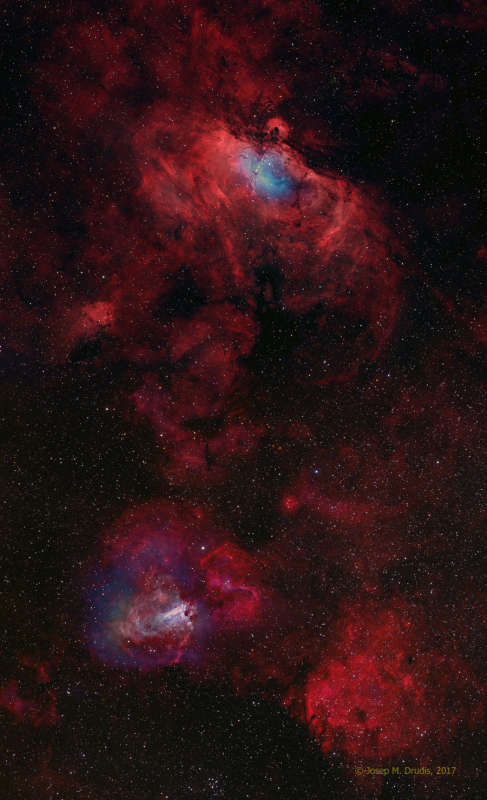Credit & Copyright: Josep Drudis
Explanation:
The Eagle Nebula and the Swan Nebula span
this
broad starscape, a telescopic view toward the
Sagittarius
spiral arm and the center of our Milky Way galaxy.
The Eagle, also known as M16, is at top and M17, the Swan,
at bottom of the frame showing the cosmic clouds as
brighter regions of active star-formation.
They lie along the spiral arm suffused with
reddish emission charactistic of
atomic hydrogen gas, and dusty dark nebulae.
M17, also called the Omega Nebula, is about 5500 light-years away,
while M16 is some 6500 light-years distant.
The center of both nebulae are locations of well-known
close-up
images of
star
formation from the Hubble Space Telescope.
In this mosaic image that extends about 3 degrees across the sky,
narrowband, high-resultion image data has been used to enhance the
central
regions of the Eagle and Swan.
The extended wings of the Eagle Nebula spread almost 120
light-years.
The Swan is over 30 light-years across.
1999 2000 2001 2002 2003 2004 2005 2006 2007 2008 2009 2010 2011 2012 2013 2014 2015 2016 2017 2018 2019 2020 2021 2022 2023 2024 2025 |
Yanvar' Fevral' Mart Aprel' Mai Iyun' Iyul' Avgust Sentyabr' Oktyabr' Noyabr' Dekabr' |
NASA Web Site Statements, Warnings, and Disclaimers
NASA Official: Jay Norris. Specific rights apply.
A service of: LHEA at NASA / GSFC
& Michigan Tech. U.
|
Publikacii s klyuchevymi slovami:
M 16 - M 17 - Tumannost' Orla - Tumannosti mezhzvezdnye
Publikacii so slovami: M 16 - M 17 - Tumannost' Orla - Tumannosti mezhzvezdnye | |
Sm. takzhe:
Vse publikacii na tu zhe temu >> | |
